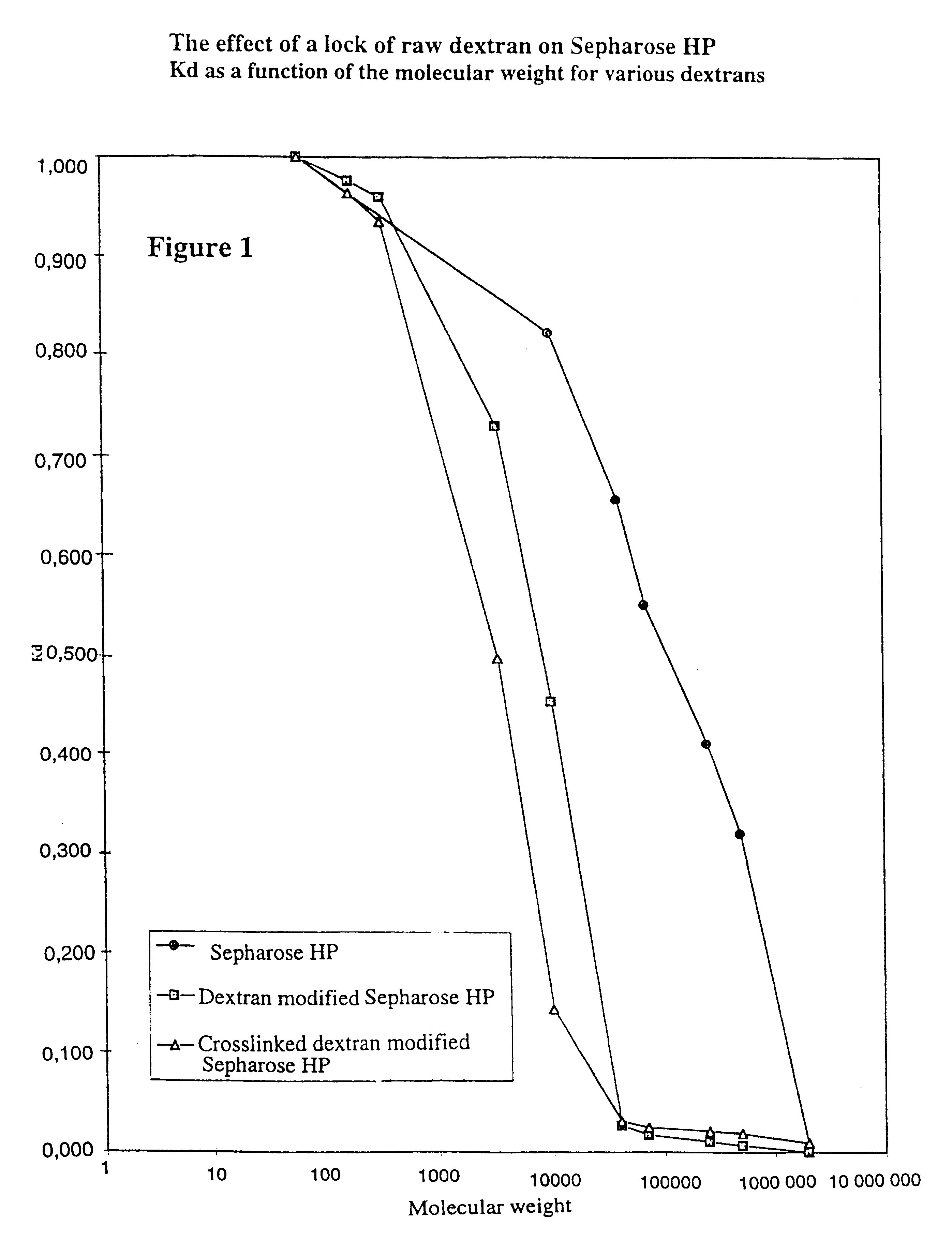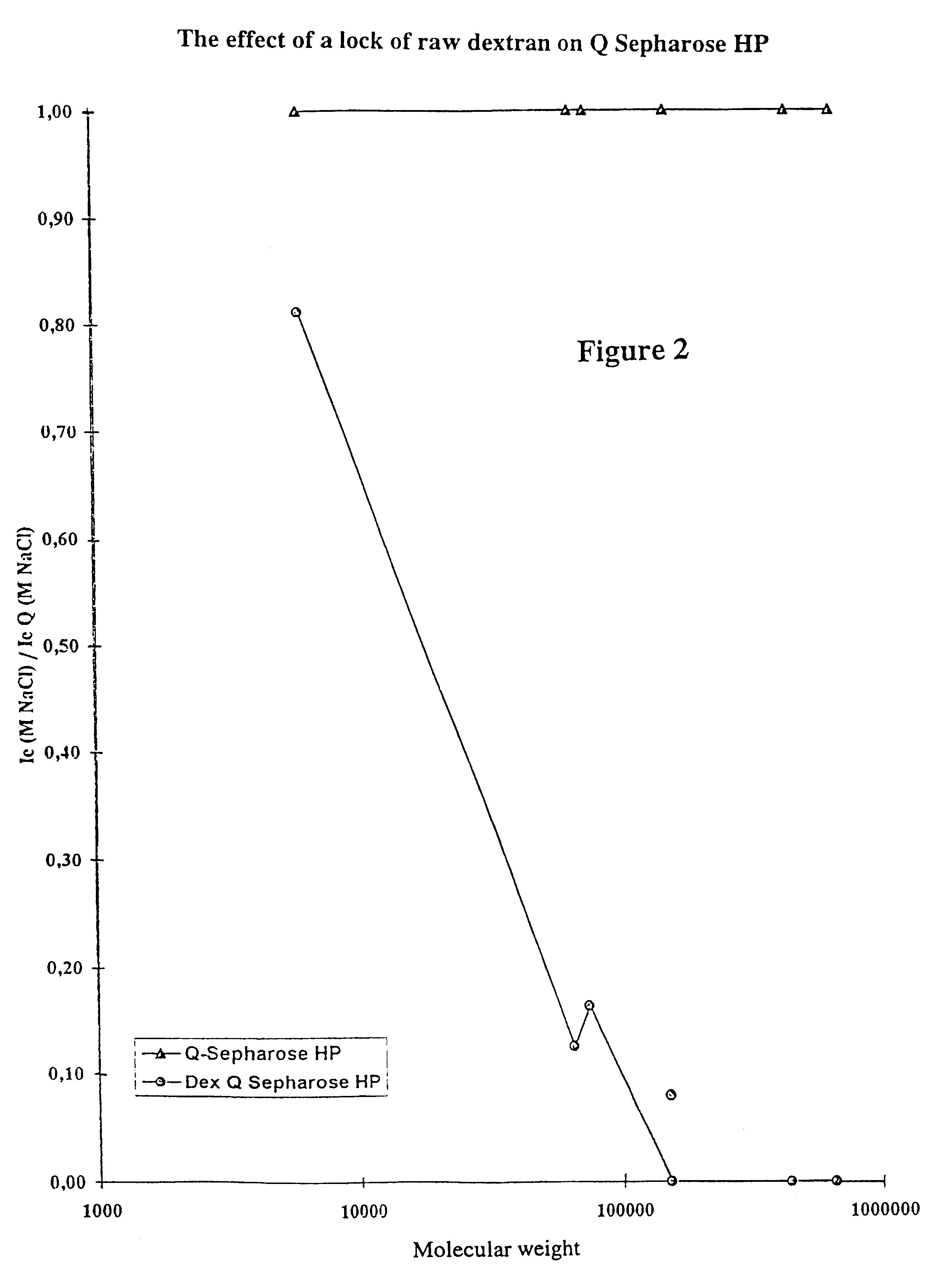Matrices for separation and separation exploiting said matrices
a technology of matrices and matrices, applied in the field of matrices, can solve the problems of limiting the ability to achieve purification, cumbersome and costly chromatographic steps, and inability to optimally use pore types, and achieve the effect of simplifying the separation of particles and large practical advantages
- Summary
- Abstract
- Description
- Claims
- Application Information
AI Technical Summary
Benefits of technology
Problems solved by technology
Method used
Image
Examples
example 1
Cross-linked Allylated Agarose in Particle Shape Coated With Raw Dextran
A. Production of cross-linked allylated agarose in particle shape Cross-linked agarose (34 .mu.m particles) produced by a reaction between epichlorohydrin and agarose in the presence of NaOH according to Porath et al. (J. Chromatog. 60 (1971) 167-77 and U.S. Pat. No. 3,959,251) was reacted with allylglycidyl ether with NaOH as a base to an allyl level (CH.sub.2.dbd.CHCH.sub.2 OCH.sub.2 CHOHCH.sub.2 --) of 0.21 mmole / mL gel. In aqueous media we have succeeded to produce gels with an allyl level in the interval 0.005-0.450 mmole / mL gel. If the reaction is performed in organic solvents even higher substitution degrees can be obtained.
B. Dissolving of raw dextran. Raw dextran is a non-hydrolyzed dextran from Leuconostoc mesenteroides with ultrahigh molecular weight, often between 10-30 million Dalton. Following purification with repeated ethanol precipitations, raw dextran is in principle completely free from low mo...
example 2
Cross-linking of Particle Used in Example 1. Cross-linker 1,4-Butanediol Diglycidyl Ether
44.8 g of particles according to example 1 coated with raw dextran are weighed in dry aspirated form in a previously calibrated plastic meter glass, and then the volume is adjusted with distilled water to 75 mL (total water and gel). The mixture is then transferred to a 250 mL three-necked round flask to which is added 15 mL 1,4-butanediol diglycidyl ether at room temperature. Thereafter, 35.0 mL of 11 M KOH (0.385 mole) is added to the vessel by pumping at 0.3 mL / min (start). This takes about 2 hours. The temperature of the thermostat is set to 40.degree. C. Stirring. The reaction is allowed to proceed over night (about 16 hours) and is stopped by neutralisation with conc. HOAc to a pH below 7, preferably 5-6, after which the mixture is filtered on a glass filter and finally the gel is washed with distilled water.
example 3
Phenyl Sepharose HP Coated With High Molecular Weight Dextran
A. Production of phenyl substituted cross-linked allylated agarose (allylated Phenyl Sepharose HP): Phenyl Sepharose HP is commercially available from Amersham Pharmacia Biotech AB. It consists of phenylated cross-linked agarose (34 .mu.m particles). Allylation is achieved by reacting the finished particle with allylglycidyl ether with NaOH as a base to an allyl level (CH.sub.2.dbd.CHCH.sub.2 OCH.sub.2 CHOHCH.sub.2 --) of 0.17 mmole / mL.
B. Dissolving of raw dextran: 53.5 g of ethanol precipitated and freeze dried raw dextran is dissolved in 325 mL distilled water in a 1,000 mL flask with slow stirring.
C. Bromination of allylated Phenyl Speharose HP: 250 mL allylated Phenyl Sepharose HP produced in step A, 250 mL distilled water and 5.23 g NaOAc (anhydrous) are added to a 1,000 mL three-necked round flask. Thereafter, an excess of elementary bromine is added by dripping to achieve bromination, and then the gel is washed on a...
PUM
| Property | Measurement | Unit |
|---|---|---|
| diameter | aaaaa | aaaaa |
| particle size | aaaaa | aaaaa |
| Stokes radius | aaaaa | aaaaa |
Abstract
Description
Claims
Application Information
 Login to View More
Login to View More - R&D
- Intellectual Property
- Life Sciences
- Materials
- Tech Scout
- Unparalleled Data Quality
- Higher Quality Content
- 60% Fewer Hallucinations
Browse by: Latest US Patents, China's latest patents, Technical Efficacy Thesaurus, Application Domain, Technology Topic, Popular Technical Reports.
© 2025 PatSnap. All rights reserved.Legal|Privacy policy|Modern Slavery Act Transparency Statement|Sitemap|About US| Contact US: help@patsnap.com



